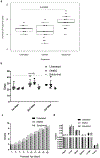Salubrinal enhances eIF2α phosphorylation and improves fertility in a mouse model of Classic Galactosemia
- PMID: 31362041
- PMCID: PMC6751024
- DOI: 10.1016/j.bbadis.2019.07.010
Salubrinal enhances eIF2α phosphorylation and improves fertility in a mouse model of Classic Galactosemia
Abstract
Loss of galactose-1 phosphate uridylyltransferase (GALT) activity in humans results in Classic Galactosemia, and the GalT-deficient (GalT-/-) mouse mimics the patient condition. GalT-/- ovaries display elevated endoplasmic reticulum (ER) stress marker, BiP, and downregulated canonical phosphatidylinositol 3-kinase (Pi3k)/protein kinase B (Akt) growth/pro-survival signaling. Numbers of primordial follicles are reduced in the mutants, recapitulating the accelerated ovarian aging seen in human patients. We previously found that oral administration of the compound Salubrinal (an eIF2α phosphatase inhibitor), resulted in reduction of ovarian BiP expression, rescued Pi3k/Akt signaling, and a doubling of primordial follicles in GalT-/- adults. Here, we further characterized galactosemic stress in GalT-/- mice versus wild-type (WT) controls, and examined whether Salubrinal treatment improved broader reproductive parameters. We assessed the expression levels of factors of the unfolded protein response (UPR), and found that BiP, phospho-Perk, and phospho-eIF2α were all elevated in GalT-/- ovaries. However, neither IKK activation (NFκB pathway) nor alternative Xbp1 splicing downstream of ER membrane protein Ire1α activation was induced, suggesting an Xbp1-independent UPR in galactosemic stress. Moreover, Salubrinal treatment significantly increased the number of ovulated eggs in mutant animals after gonadotrophic superovulation. Salubrinal treatment also normalized estrus cycle stage lengths and resulted in significantly larger litter sizes than vehicle-treated mutants. Overall, we show that Salubrinal protects against galactosemia-induced primordial follicle loss in a fashion that includes suppressing the de-phosphorylation of eIF2α, and that intervention in this way significantly improves and extends ovarian function, fertility, and fecundity.
Keywords: Classic Galactosemia; Galactosemic stress; Perk branch of the unfolded protein response (UPR); Pi3K/Akt signaling; Salubrinal; Subfertility.
Copyright © 2019 Elsevier B.V. All rights reserved.
Figures






Similar articles
-
Reversal of aberrant PI3K/Akt signaling by Salubrinal in a GalT-deficient mouse model.Biochim Biophys Acta Mol Basis Dis. 2017 Dec;1863(12):3286-3293. doi: 10.1016/j.bbadis.2017.08.023. Epub 2017 Aug 26. Biochim Biophys Acta Mol Basis Dis. 2017. PMID: 28844959
-
PERK (Protein Kinase RNA-Like ER Kinase) Branch of the Unfolded Protein Response Confers Neuroprotection in Ischemic Stroke by Suppressing Protein Synthesis.Stroke. 2020 May;51(5):1570-1577. doi: 10.1161/STROKEAHA.120.029071. Epub 2020 Mar 26. Stroke. 2020. PMID: 32212900 Free PMC article.
-
Salubrinal promotes phospho-eIF2α-dependent activation of UPR leading to autophagy-mediated attenuation of iron-induced insulin resistance.Mol Metab. 2024 May;83:101921. doi: 10.1016/j.molmet.2024.101921. Epub 2024 Mar 26. Mol Metab. 2024. PMID: 38527647 Free PMC article.
-
Experimental Evidence Shows Salubrinal, an eIF2α Dephosphorylation Inhibitor, Reduces Xenotoxicant-Induced Cellular Damage.Int J Mol Sci. 2015 Jul 17;16(7):16275-87. doi: 10.3390/ijms160716275. Int J Mol Sci. 2015. PMID: 26193263 Free PMC article. Review.
-
Targeting phosphorylation of eukaryotic initiation factor-2α to treat human disease.Prog Mol Biol Transl Sci. 2012;106:75-106. doi: 10.1016/B978-0-12-396456-4.00005-5. Prog Mol Biol Transl Sci. 2012. PMID: 22340715 Review.
Cited by
-
Integrated stress response control of granulosa cell translation and proliferation during normal ovarian follicle development.Mol Hum Reprod. 2021 Aug 7;27(8):gaab050. doi: 10.1093/molehr/gaab050. Mol Hum Reprod. 2021. PMID: 34314477 Free PMC article.
-
Diverse roles of stress-responsive RNP granules in oogenesis and infertility.Biol Reprod. 2025 Jun 15;112(6):1039-1053. doi: 10.1093/biolre/ioaf057. Biol Reprod. 2025. PMID: 40114304 Free PMC article. Review.
-
Mammalian integrated stress responses in stressed organelles and their functions.Acta Pharmacol Sin. 2024 Jun;45(6):1095-1114. doi: 10.1038/s41401-023-01225-0. Epub 2024 Jan 24. Acta Pharmacol Sin. 2024. PMID: 38267546 Free PMC article. Review.
-
Pathophysiology and management of classic galactosemic primary ovarian insufficiency.Reprod Fertil. 2021 Jun 25;2(3):R67-R84. doi: 10.1530/RAF-21-0014. eCollection 2021 Jul. Reprod Fertil. 2021. PMID: 35118398 Free PMC article. Review.
-
Early postnatal alterations in follicular stress response and survival in a mouse model of Classic Galactosemia.J Ovarian Res. 2022 Nov 21;15(1):122. doi: 10.1186/s13048-022-01049-2. J Ovarian Res. 2022. PMID: 36414970 Free PMC article.
References
Publication types
MeSH terms
Substances
Grants and funding
LinkOut - more resources
Full Text Sources
Medical
Molecular Biology Databases

